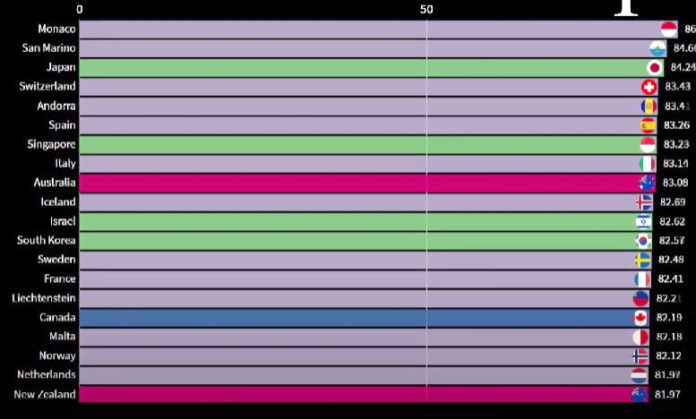Life expectancy and death rates are considered some of the important indices of assessment regarding the general health condition and lifestyle of the population. They reflect the whole health situation, which provides valuable insight into the effectiveness of healthcare systems, the effects of socio-economic determinants, and the influence of lifestyles on longevity.
This paper will review key aspects of life expectancy and death, examining global trends, what influences these measures, and what this might mean for future generations.
What is life expectancy?
Life expectancy refers to the average number of years a person is expected to live, based on the present rate of mortality. It is a very different statistic across countries and even within regions of countries. Because it reflects differences in health care, economic conditions, and social environments.
Factors Contributing to Life Expectancy
1. Access and Quality of Health Care
The most common determinant of life expectancy involves access to quality health care services. Where countries have effective healthcare systems, there will be higher life expectancy rates because diseases can be better prevented, diagnosed, and treated.
2. Economic Stability
Life expectancy is directly influenced by economic conditions. In fact, wealthy nations can invest more in healthcare, education, and social services, all of which combine to extend life expectancy. Quite the opposite is true regarding many of the poor. Poverty is frequently associated with a lack of access to basics, along with increased stress and malnutrition, all factors generally reducing life expectancy.
3. Lifestyle Choices
Lifestyle factors are very important in the determination of life expectancy, including diet, exercise, smoking, and alcohol consumption. Populations with healthy lifestyles tend to live longer.
4. Environmental Factors
It is quite important in determining life expectancy. Poor air and water quality exposes one to environmental toxins and pollutants that may result in illnesses and chronic conditions leading to a shorter lifespan.
5. Genetics
Genetics can determine an individual’s life expectancy by predisposing one to a number of diseases and by generally affecting resistance to health hazards.
Trends in Global Life Expectancy
The general trend across the globe has seen life expectancy rise over the past one hundred years due to improvements in medicine and living standards, as well as better public health. The life expectancy for people living in developed countries, however, is considerably higher compared to people living in developing countries.
- High-Income Countries: Japan, Switzerland, and Australia are representatives of countries that have one of the highest life expectancies, usually exceeding 80 years. In general, these countries would be associated with strong health care systems, robust economies, and healthy living styles.
- Low-Income Countries: Most of the low-income countries have life expectancy below 60 years. Poor access to healthcare, a high burden of infectious diseases, and political instability are contributing factors.
- Impact of Pandemics: The COVID-19 pandemic has reduced life expectancy for a period of time in much of the world. Thus showing the vulnerability of global health systems.
- Understanding Death Rates: The death rate is the number of deaths per 1,000 members within a given population during a specific time. This measure can be used to determine the overall mortality rate of a population and can even present signs of a public health problem.
Key Factors Affecting Death Rates
1. Disease Prevalence
The prevalence of diseases, more so chronic conditions such as heart disease, cancer, and diabetes, effectively determines the death rates. Control and management of such diseases result in the reduction of mortality rates.
2. Age Structure
The populations that have more elderly people will tend to have higher death rates simply. Because of the aging process and also health complications that come with this stage in life.
3. Accidents and Violence
Unintentional injury deaths also contribute to mortality from traffic accidents and violence, particularly among younger age groups.
4. Public Health Interventions
Public health initiatives, such as vaccination programs and antismoking campaigns, reduce disease deaths and encourage healthier lifestyles.
Relationship Life Expectancy and Death Rates
Life expectancy and mortality rates allow the assessment of different facets of health, although they are related. While life expectancy covers the average a person is expected to live, death rates put into perspective the frequency at which deaths occur in a population. Both measures are essential in formulating policies to improve health and understand the trends in public health.
Life expectancy and mortality rate are important parameters that assess population health. They not only reflect the efficiency of health care systems but also economic conditions and ways of life. While life expectancy for the whole world is higher, within different countries and between high-income and low-income countries, discrepancies continue. Understanding what drives these measures will better prepare development toward public health improvement to assure more generations of healthier and longer lives.
FAQs
1. How is life expectancy estimated?
Life expectancy can be approximated with the help of life tables, depending upon the age-specific mortality rates of different age groups constituting the population.
2. Why does life expectancy tend to be higher for women than for men?
Generally speaking, on account of biological factors presenting a hormonal advantage, women live longer than men; likewise, socially, the risks to life are generally lesser for them.
3. Will lifestyle changes make a big difference to one’s life expectancy?
Yes, through healthy living-frequent exercise and proper nutrition-aside from avoiding vices such as smoking, life expectancy can be further extended by as much as decades.

